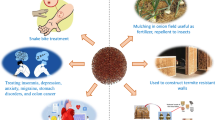Abstract
Fatty acid desaturase-2 (FAD2) introduces a double bond in position Δ12 in oleic acid (18:1) to form linoleic acid (18:2 n-6) in higher plants and microbes. A new transgenic expression cassette, containing CMV promoter/fad2 cDNA/SV40 polyA, was constructedto produce transgenic mice. Among 63 healthy offspring, 10 founders (15.9%) integrated the cotton fad2 transgene into their genomes, as demonstrated by PCR and Southern blotting analysis. All founder mice were fertile and heterozygous fad2 female and nontransgenic littermates were used for fatty acid analysis using gas chromatography. One fad2 transgenic line showed substantial differences in the fatty acid profiles and the level of linoleic acid was increased 19% (P<0.05) in transgenic muscles compared to their nontransgenic littermates. Moreover, it exhibited an 87% and a 9% increase (P<0.05) in arachidonic acid (20:4 n-6) in muscles and liver, compared to their nontransgenic littermates. The results indicate that the plant fad2 gene can be functionally expressed in transgenic mice and may playan active role in conversion of oleic acid into linoleic acid.
Similar content being viewed by others
References
Marszalek J R, Lodish H F. Docosahexaenoic acid, fatty acid-interacting proteins, and neuronal function: breastmilk and fish are good for you. Annu Rev Cell Dev Biol, 2005, 21: 633–657, 10.1146/annurev.cellbio.21.122303.120624, 1:CAS:528:DC%2BD2MXhtlektbvF, 16212510
Kang J X. The importance of omega-6/omega-3 fatty acid ratio in cell function. The gene transfer of omega-3 fatty acid desaturase. World Rev Nutr Diet, 2003, 92: 23–36, 10.1159/000073790, 1:CAS:528:DC%2BD3sXhtVWnsLjO, 14579681
Simopoulos A P. Omega-3 fatty acids in health and disease and in growth and development. Am J Clin Nutr, 1991, 54: 438–463, 1:CAS:528:DyaK3MXmtVKlurw%3D, 1908631
Saeki K, Matsumoto K, Kinoshita M, et al. Functional expression of a Delta12 fatty acid desaturase gene from spinach in transgenic pigs. Proc Natl Acad Sci USA, 2004, 101: 6361–6366, 10.1073/pnas.0308111101, 1:CAS:528:DC%2BD2cXjvVyitrY%3D, 15067141
Niemann H. Transgenic pigs expressing plant genes. Proc Natl Acad Sci USA, 2004, 101: 7211–7212, 10.1073/pnas.0402011101, 1:CAS:528:DC%2BD2cXksFaksr8%3D, 15128943
Wang Y, An X R, Liu Q, et al. Establishment of transgenic mice integrated with gene encoding cotton omega-6 fatty acid desaturase-2. J Agri Biotechnol, 2005, 13: 207–211, 1:CAS:528:DC%2BD2MXht1akurrO
Sambrook J, Fritsch E F, Maniatis T. Molecular Cloning: A Laboratory Mannual 3th ed. Cold Spring Harbor: Cold Spring Harbor Laboratory Press. 2001.
Kang J X, Wang J. A simplified method for analysis of polyunsaturated fatty acids. BMC Biochem, 2005, 6: 5, 10.1186/1471-2091-6-5, 15790399, 1:CAS:528:DC%2BD2MXksF2isrs%3D
Giraldo P, Montoliu L. Size matters: Use of YACs, BACs and PACs in transgenic animals. Transgenic Res, 2001, 10: 83–103, 10.1023/A:1008918913249, 1:CAS:528:DC%2BD3MXis1Kmur0%3D, 11305364
Martinez M. Tissue levels of polyunsaturated fatty acids during early human development. J Pediatr, 1992, 120: S129–S138, 10.1016/S0022-3476(05)81247-8, 1:CAS:528:DyaK38XisFarsLs%3D, 1532827
Innis S M. Polyunsaturated fatty acids in human milk: An essential role in infant development. Adv Exp Med Biol, 2004, 554: 27–43, 1:CAS:528:DC%2BD2MXlvVClt7s%3D, 15384565
Madsen L, Pedersen L M, Liaset B, et al. cAMP-dependent signaling regulates the adipogenic effect of n-6 polyunsaturated fatty acids. J Biol Chem, 2008, 283: 7196–7205, 10.1074/jbc.M707775200, 1:CAS:528:DC%2BD1cXivFyju7w%3D, 18070879
Morimoto K C, Van Eenennaam A L, DePeters E J, et al. Endogenous production of n-3 and n-6 fatty acids in mammalian cells. J Dairy Sci, 2005, 88: 1142–1146, 1:CAS:528:DC%2BD2MXitFygtbg%3D, 15738247, 10.3168/jds.S0022-0302(05)72780-6
Kang J X, Wang J, Wu L, et al. Transgenic mice: Fat-1 mice convert n-6 to n-3 fatty acids. Nature, 2004, 427: 504, 10.1038/427504a, 1:CAS:528:DC%2BD2cXpsFWhtA%3D%3D, 14765186
Jia Q, Lupton J R, Smith R, et al. Reduced colitis-associated colon cancer in Fat-1 (n-3 fatty acid desaturase) transgenic mice. Cancer Res, 2008, 68: 3985–3991, 10.1158/0008-5472.CAN-07-6251, 1:CAS:528:DC%2BD1cXlvVOhsr8%3D, 18483285
Nowak J, Weylandt K H, Habbel P, et al. Colitis-associated colon tumorigenesis is suppressed in transgenic mice rich in endogenous n-3 fatty acids. Carcinogenesis, 2007, 28: 1991–1995, 10.1093/carcin/bgm166, 1:CAS:528:DC%2BD2sXhtFWhu77J, 17634405
Hudert C A, Weylandt K H, Lu Y, et al. Transgenic mice rich in endogenous omega-3 fatty acids are protected from colitis. Proc Natl Acad Sci USA, 2006, 103: 11276–11281, 10.1073/pnas.0601280103, 1:CAS:528:DC%2BD28XnvVCmtrc%3D, 16847262
Xia S, Lu Y, Wang J, et al. Melanoma growth is reduced in fat-1 transgenic mice: Impact of omega-6/omega-3 essential fatty acids. Proc Natl Acad Sci USA, 2006, 103: 12499–12504, 10.1073/pnas.0605394103, 1:CAS:528:DC%2BD28Xos1Onsrk%3D, 16888035
Connor K M, SanGiovanni J P, Lofqvist C, et al. Increased dietary intake of omega-3-polyunsaturated fatty acids reduces pathological retinal angiogenesis. Nat Med, 2007, 13: 868–873, 10.1038/nm1591, 1:CAS:528:DC%2BD2sXnsFWmtrw%3D, 17589522
Lai L, Kang J X, Li R, et al. Generation of cloned transgenic pigs rich in omega-3 fatty acids. Nat Biotechnol, 2006, 24: 435–436, 10.1038/nbt1198, 1:CAS:528:DC%2BD28Xjt1Wisb4%3D, 16565727
Almendingen K, Hostmark A T, Fausa O, et al. Familial adenomatous polyposis patients have high levels of arachidonic acid and docosa-hexaenoic acid and low levels of linoleic acid and alpha-linolenic acid in serum phospholipids. Int. J Cancer, 2007, 120: 632–637, 10.1002/ijc.22337, 1:CAS:528:DC%2BD28XhtlGqsrfF, 17096349
Polesel J, Talamini R, Montella M, et al. Linoleic acid, vitamin D and other nutrient intakes in the risk of non-Hodgkin lymphoma: An Italian case-control study. Ann Oncol, 2006, 17: 713–718, 10.1093/annonc/mdl054, 1:STN:280:DC%2BD287mslSrtg%3D%3D, 16556850
Reyes N, Reyes I, Tiwari R, et al. Effect of linoleic acid on proliferation and gene expression in the breast cancer cell line T47D. Cancer Lett, 2004, 209: 25–35, 10.1016/j.canlet.2003.12.010, 1:CAS:528:DC%2BD2cXktVClurg%3D, 15145518
Kilian M, Mautsch I, Gregor J I, et al. Influence of conjugated vs. conventional linoleic acid on liver metastasis and hepatic lipidper-oxidation in BOP-induced pancreatic cancer in Syrian hamster. Prostaglandins Leukot. Essent Fatty Acids, 2002, 67: 223–228, 10.1054/plef.2002.0422, 1:CAS:528:DC%2BD38XosVSiu7k%3D
Author information
Authors and Affiliations
Corresponding author
Additional information
Supported by the National Basic Research and Development Program of China (Grant No. 2004CB117500), the National Natural Science Foundation of China (Grant No. 30571332), and the National Major Special Project on New Varieties Cultivation for Transgenic Organisms (Grant No. 2008ZX08008-003)
Rights and permissions
About this article
Cite this article
Chen, Q., Liu, Q., Wu, Z. et al. Generation of fad2 transgenic mice that produce omega-6 fatty acids. SCI CHINA SER C 52, 1048–1054 (2009). https://doi.org/10.1007/s11427-009-0143-z
Received:
Accepted:
Published:
Issue Date:
DOI: https://doi.org/10.1007/s11427-009-0143-z




